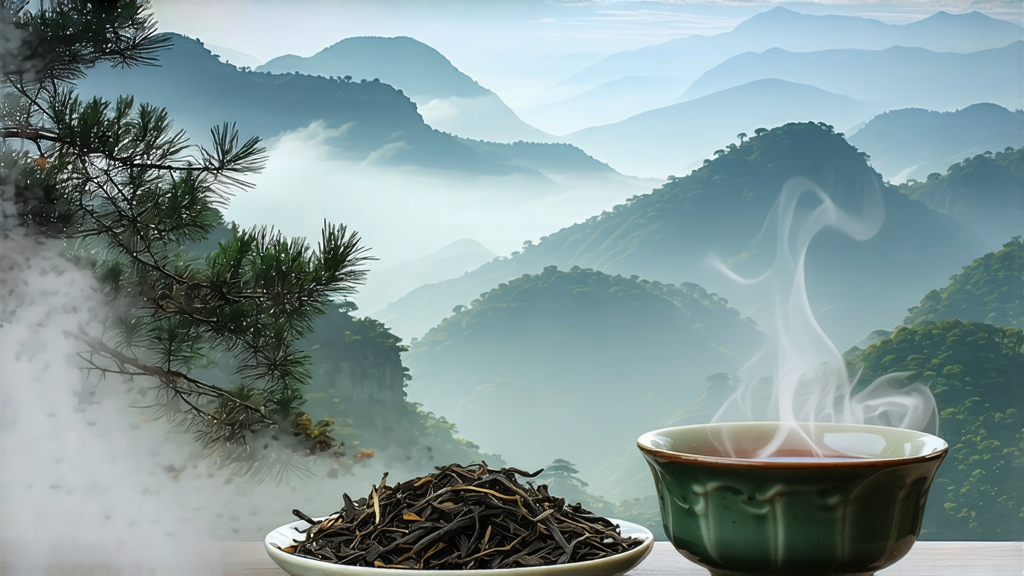
When European tea clippers first rounded the Cape of Good Hope in the late 1600s, the cargo that most excited London merchants was not silk or porcelain, but small, glossy, black-leafed chests labeled “Bohea.” That mysterious word was the earliest romanization of “Wuyi,” the cliff-lined range in northern Fujian where the world’s first fully oxidized tea—what we now call black tea—was born. The variety that filled those chests was Lapsang Souchong, a tea whose very name carries the DNA of its origin: “souchong” refers to the fourth and fifth leaves plucked lower on the bush, while “Lapsang” nods to the mountain village of Tongmu, where the smoke that curls from pinewood fires forever altered the flavor of tea.
History: From Misty Gorges to London Coffee-Houses
Local legend places the birth of Lapsang Souchong during the Ming dynasty, around 1567–1610, when passing soldiers commandeered a tea factory and hurried the drying process over open pine fires. The accidental smoke infusion proved so popular that it became deliberate, and by the early Qing the tea was traveling the Tea Horse Road to the Russian border, then onward to Amsterdam and London. Samuel Pepys mentions drinking “a cup of Bohea” in his 1667 diary; Catherine of Braganza’s dowry chests reputedly carried it to the English court; and by 1795 the East India Company was auctioning Tongmu lots at prices higher than silver. The tea’s robust, sweet-smoke character suited European palates accustomed to peat-whisky and pipe tobacco, and it became the template for every “black” tea that followed—Keemun, Assam, Ceylon—earning Lapsang Souchong the title “ancestor of all red tea.”
Terroir: Why Only Tongmu Can Be True Tongmu
The Wuyi Mountains rise in sheer sandstone cliffs, their ravines trapping a humid, fog-laden microclimate that moderates temperature and filters sunlight into a soft, diffused glow. Day-night swings of 15 °C slow leaf growth, concentrating amino acids and volatile aromatics. The soil is a crumbly, acidic laterite rich in iron and potassium, prized by locals as “rock bone.” Crucially, Tongmu sits inside a national nature reserve; pesticides are banned, and only indigenous small-leaf tea bushes (Camellia sinensis var. sinensis, the “xiao ye zhong”) may be harvested. These factors create a leaf that is naturally low in tannin yet high in floral precursors—exactly what is needed to balance the forthcoming smoke.
Craft: The Eight Stages of Pine-Fire Alchemy
- Plucking: Only the three leaves and a bud below the canopy are taken between Qingming and Grain Rain, when spring mist is thickest.
- Withering: Baskets of leaves are laid on latticed racks inside wooden lofts heated indirectly by pine embers; cool smoke drifts through for 8–10 hours, reducing moisture to 60 %.
- Rolling: Once limp, leaves are hand-rolled on bamboo trays to rupture cell walls, initiating oxidation.
- Oxidation: The rolled leaf is piled in copper-lined crates and left in a humid, 24 °C room for 3–5 hours, turning from jade to copper to dark mahogany.
- Pan-firing: A quick 220 °C tumble in iron woks halts oxidation, fixing the color and caramelizing sugars.
- Smoking: The signature step—leaves are spread on sieves suspended over slow-burning pinewood logs from Masson pine and Chinese red pine. Resin-rich heartwood smolders at 80–90 °C for 6–8 hours, bathing the tea in alpha-pinene and longifolene vapors that bond to the leaf surface.
- Re-firing: After a 48-hour rest, a second, shorter firing tightens the leaf and stabilizes the smoke.
- Sorting: Masters known as “nose men” sniff every batch; only teas that show “longan-sweet top, resinous body, and clean, cooling finish” are stamped with the Tongmu seal.
Two Styles: Traditional Smoke vs. New-Age Unsmoked
While the pine-smoked classic remains the benchmark, a quieter, unsm